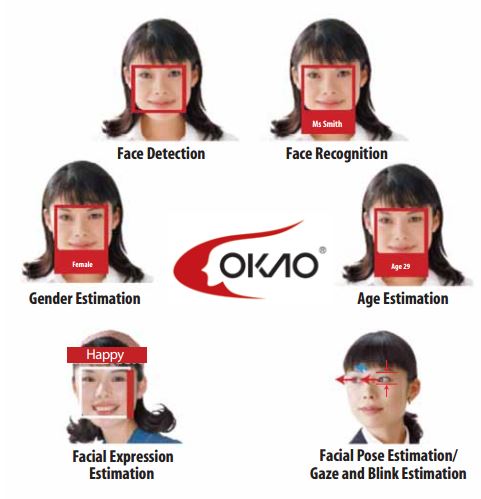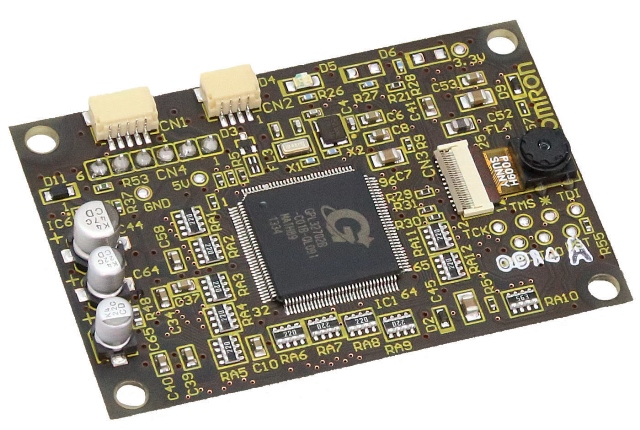People today interact with a wide variety of machines in their daily lives, be it a getting a snack from a vending machine, withdrawing some cash from an ATM, or using a self-checkout station at a local grocery store. In every case, it is up to the user to adapt to the machine in order to successfully interface with it. For some, this is easy, but for others it can make for a challenging and stressful situation. Soon, however, advancements in technology will help bridge this gap between people and machines, providing a more effective and enjoyable user experience, no matter the age or skill level of the person. One such technology is Image Sensing Technology.
Image Sensing Technology analyzes an image taken by a camera and provides data about the contents of that image. Omron has been a pioneer in Image Sensing Technology for over 15 years with its OKAO Vision software IP. The term OKAO is the Japanese word for “face”, so it’s no surprise that Omron’s technology is mainly focused on capturing information about a person’s face offering such features as Face Detection, Face Recognition, and Age/Gender Estimation (fig. 1 ). OKAO Vision has received both critical and commercial success having been licensed over 500 million times worldwide.

Fig. 1: OKAO Image Sensing Technology
Omron’s latest entry into the Image Sensing space comes in the form of a hardware device dubbed Human Vision Components (HVC) (fig. 2). The HVC integrates Omron’s best in class OKAO Vision algorithms along with a camera, processor, and external interface onto a single PCB, sized at 60×40 mm. Each HVC includes the following 10 functions:
- -Face Detection
- -Face Recognition
- -Gender Estimation
- -Age Estimation
- -Expression Estimation
- -Facial Pose Estimation
- -Gaze Estimation
- -Blink Estimation
- -Hand Detection
- -Human Body Detection

Fig. 2: Omron's Human Vision Components (HVC) hardware
The module effectively acts as a sensor, using the camera and built in functions to capture information about a person or people that it sees, and then transmits this data using serial communication via UART. The end result is an image sensor that offers high functionality and is easy to use.
“HVC was designed to bring image sensing to the masses. In the past, if an application wanted access to such state of the art technology, it required significant amounts of engineering work to be done. Omron’s HVC simplifies the entire process. Simply connect the HVC into your application and interface with it like any other digital sensor”, says David Schroll, Product Marketing Specialist for sensors at Omron.
HVC can assist a multitude of applications where human interaction is a critical component of the overall user experience. Some examples include:
- Vending Machines – Use Age/Gender Estimation to make product recommendations to customers.
- Automotive – Face Recognition can be used to personalize automobile settings, which can be used for things such as seat adjustments, radio presets, mirror adjustments, etc.
- Home Appliance – Human Body Detection can be used for energy conservation in home appliances like air conditioners which can power down when no one is present.
- Robotics – Communication Robots can adjust talking speed and volume by using Facial Expression estimation.
- Digital Signage – Age / Gender Estimation can assist in more effective advertisements, changing the ad based on who is in front of the sign.
While the current version of the HVC is the first of its kind for Omron, it certainly won’t be the last. The company has big plans for this type of sensor and feels it will play a key role in the organization’s growth. New models are currently in development to expand Omron’s product lineup, making it easy for companies that want to use this kind of sensor to have access to one that will meet all of their requirements.
Additionally, Omron also plans to expand the HVC into the consumer space. The HVC-C(C for consumer) will have the appearance of a web camera, but offers the same image sensing functions of its older brother. One key difference though is that the HVC-C will offer wireless communication via Wi-Fi. The device is designed to communicate with iOS and Android devices. Consumers will be able to download an app to their phones or tablets that will essentially talk with the HVC-C. It will then transmit the image sensing data to the smart device for the application to use. The best part is that the HVC platform will be completely open sourced so that any and all developers can create applications for the HVC-C without added costs.
Image sensing continues to make great strides, bridging the gap between people needing to adapt to machines. New products such as Omron’s HVC make it easier than ever for applications to access such technology, providing a more pleasant user experience.
Advertisement
Learn more about Omron Electronic Components





